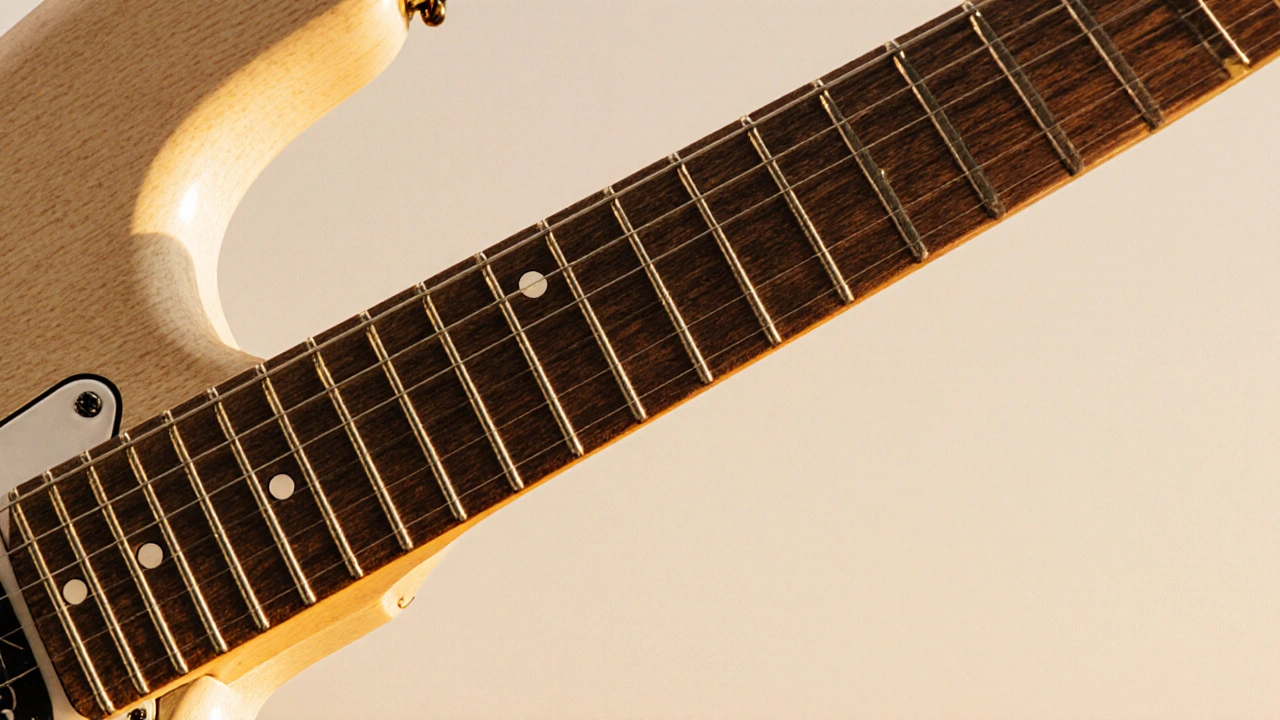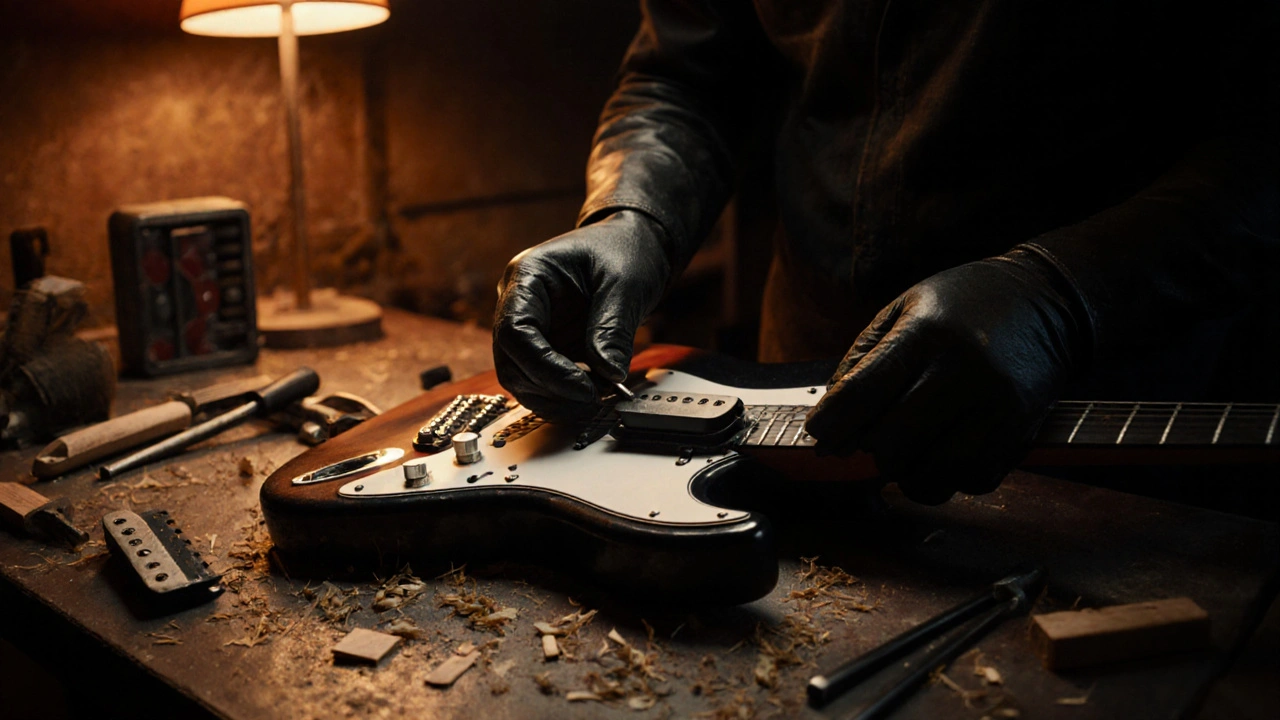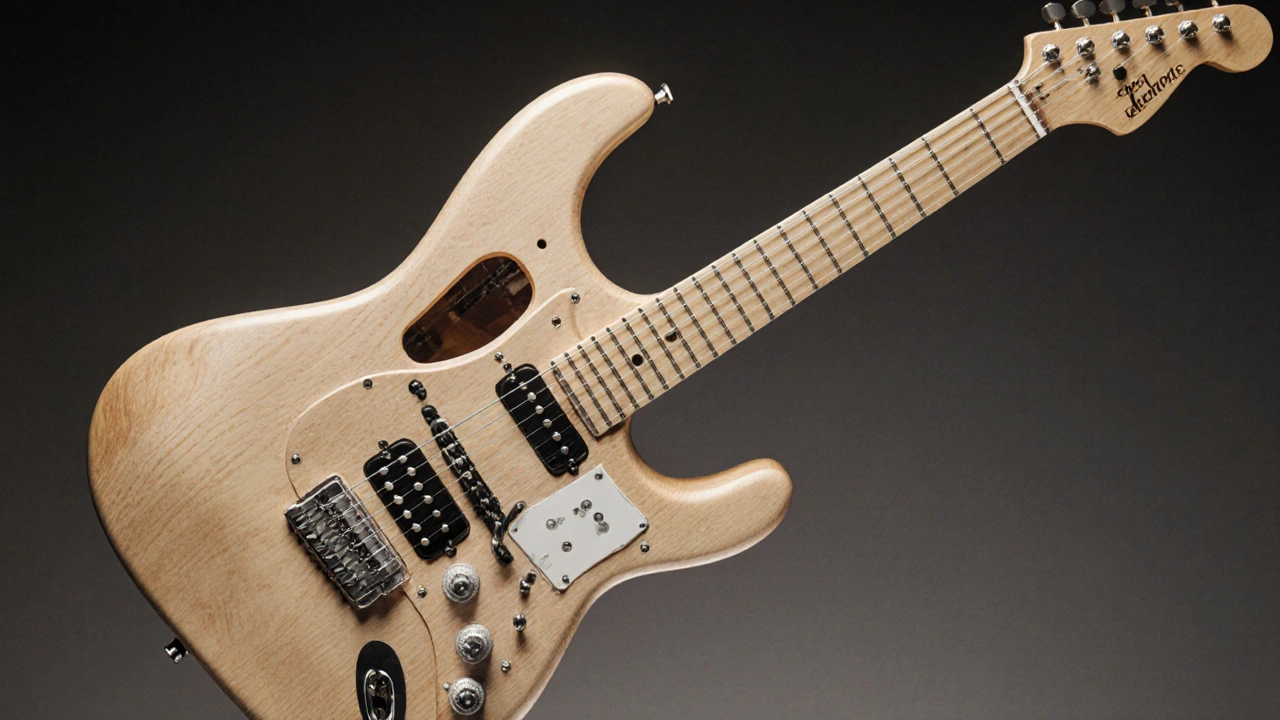Guitar Pickup Selector
Find Your Perfect Pickup Type
Pickup Type Comparison
Single-Coil
Bright, crisp, glassy sound
Humbucker
Warm, thick, higher output
P-90
Mid-range punch, raw edge
Key Takeaways
- Every electric guitar is built from a body, neck, headstock, pickups, bridge and electronics.
- The choice of tonewood, pickup type and bridge system shapes tone and playability.
- Proper setup of strings, neck relief and pickup height is essential for comfort and sound.
- Understanding each component helps you choose, modify or maintain your instrument.
The electric guitar is a stringed instrument that relies on magnetic pickups to turn string vibrations into an electrical signal is a marvel of engineering and art. From the first solid‑body models in the 1950s to today’s boutique creations, each part has a purpose. Grasping the electric guitar anatomy lets you pick the right model, tweak it for your style, and keep it sounding great for years.
Body: The Core of Tone and Style
The body houses the pickups, bridge, electronics and provides the visual identity of the instrument. Bodies come in a handful of classic shapes-Stratocaster, Telecaster, Les Paul, SG-each with its own ergonomics and tonal reputation.
Tonewood refers to the type of wood used for the body, influencing resonance, weight and sustain is a major factor. Alder and ash tend to produce bright, balanced tones, while mahogany offers warmth and depth. Basswood is light and responsive, making it popular for layered, modern sounds.
Many players add a routed cavity for a tremolo system or a hard‑tail bridge, and some modern bodies are carved from a single piece of wood, reducing seams and enhancing sustain.
Neck: Playability Meets Stability
The neck connects the body to the headstock and supports the fretboard. It is usually made from maple-often with a maple or rosewood fingerboard-though exotic woods like walnut or ebony are also used.
Neck profile describes the shape of the back of the neck, ranging from thin "C" curves to chunky "U" profiles influences comfort. A thin, fast‑playing neck suits lead work, while a thicker profile adds grip for rhythm players.
Neck construction methods-set‑in, bolt‑on, neck‑through-affect sustain and access. Bolt‑on necks (like on most Stratocasters) provide bright attack and easy repairs; set‑in necks (found on Les Pauls) boost sustain; neck‑through designs (common on high‑end guitars) give seamless access to the highest frets.

Headstock & Tuners: Tuning Precision
The headstock holds the tuning machines, also called tuners. These devices adjust string tension to keep the guitar in tune.
Tuner type includes vintage-style sealed tuners, modern sealed or gear‑less locking tuners, and vintage‑style staggered tuners impacts tuning stability and string changes speed.
Locking tuners (often found on guitars with a tremolo system) clamp the string, reducing slip and cutting down string‑change time. The angle of the headstock can also affect string tension-tilted back heads increase tension, while angled heads reduce it.
Pickups & Electronics: Shaping the Signal
Pickups are magnetic transducers that capture string vibration and feed it into the guitar’s output jack. The three most common pickup designs are single‑coil, humbucker and P‑90.
| Type | Sound Character | Noise Level | Typical Uses |
|---|---|---|---|
| Single‑coil | Bright, crisp, glassy | Higher hum (especially under lights) | Country, funk, classic rock |
| Humbucker | Warm, thick, higher output | Low hum, noisy environment friendly | Hard rock, metal, jazz |
| P‑90 | Mid‑range punch, raw edge | Moderate hum | Punk, indie, blues |
The pickup’s position-neck, middle, bridge-also changes tone. Neck pickups capture more string vibration, yielding warmth; bridge pickups pick up less vibration, giving bite and clarity.
Electronics refer to the control knobs, selector switches and wiring that shape the pickup signal before it leaves the guitar include volume and tone pots, a pickup selector (3‑way, 5‑way), and sometimes active circuitry requiring a battery.
Bridge & Tremolo: Transfer of Vibration
The bridge anchors the strings to the body and transfers vibration. Two major categories exist: fixed (hard‑tail) bridges and tremolo systems.
Fixed bridge provides maximum string-to-body coupling for sustain and tuning stability is common on many rock and metal guitars. Examples include the Tune‑O‑Mate and hard‑tail Strat bridge.
Tremolo system allows the player to raise or lower pitch by moving the bridge via a spring‑loaded arm comes in several forms: vintage “synchronized” tremolo (Strat), vintage‑style “tremolo” (Tele), Floyd‑Rose locking tremolo (high‑gain), and modern two‑point pivots (Fender Ultra).
Locking tremolos improve tuning stability during heavy dive‑bombs, while non‑locking units keep that classic ``shimmer`` but require careful setup.

Strings & Setup: Fine‑Tuning the Instrument
Strings are the voice of the guitar. Gauge (thickness) influences tension, tone and playability. Lighter gauges bend easier and feel softer; heavier gauges provide tighter low‑end response and more sustain.
String material includes nickel‑plated steel (balanced tone), pure nickel (warmth), stainless steel (bright, long‑lasting) and coated strings (extended life) each adds subtle tonal shifts.
Setup steps that keep the guitar sounding its best:
- Check neck relief by measuring string height at the 7th fret with a feeler gauge.
- Adjust the truss rod if the gap is too wide (more relief) or too tight (backbow).
- Set the string action at the 12th fret; typical electric guitar action is 1.5‑2.5mm.
- Intonate each string by moving the saddle until the 12th‑fret harmonic matches the fretted note.
- Adjust pickup height; closer to strings = higher output, but beware of magnetic pull affecting intonation.
Customization & Variations: Making the Guitar Your Own
Many players swap parts to tailor tone. Common upgrades include:
- Replacing stock pickups with boutique models for higher output or vintage voicing.
- Installing a different bridge (e.g., converting a tremolo to a hard‑tail for stability).
- Swapping tonewoods or adding a chambered body to reduce weight.
- Adding a coil‑tap switch to get single‑coil tones from a humbucker.
When modifying, keep an eye on the guitar’s overall balance. A heavier bridge can change the instrument’s center of gravity, affecting playing comfort.
Quick Checklist Before Buying or Refurbishing
- Identify the primary music style you play-this guides body shape, pickup configuration and neck profile.
- Test the feel of the neck; comfort is personal and outweighs any spec sheet.
- Listen to the stock pickups; decide if you need a swap for more gain or vintage sparkle.
- Check the bridge type; decide if you need a tremolo for pitch effects or a fixed bridge for stability.
- Feel the weight and balance-heavy guitars can cause fatigue on long gigs.
- Verify the tuning machines work smoothly and hold pitch under bending.
Frequently Asked Questions
What is the difference between a single‑coil and a humbucker?
Single‑coils have one magnet coil, giving bright, articulate tones but they pick up electromagnetic hum. Humbuckers use two coils wired out of phase, cancelling the hum and delivering a thicker, higher‑output sound.
Is a maple neck always brighter than a mahogany neck?
Maple is denser and tends to add a slight snap and brightness, especially when paired with a maple fingerboard. Mahogany is softer and contributes warmth. However, the overall tone also depends on body wood, pickups and hardware, so the difference isn’t always drastic.
Do locking tuners really keep a guitar in tune better?
Locking tuners clamp the string at the tuner, reducing slippage and making string changes quicker. They improve tuning stability, especially on guitars with floating tremolos, but a well‑set non‑locking tuner can also stay in tune if the nut and bridge are properly cut.
How often should I intonate my electric guitar?
Check intonation whenever you change string gauge, change the neck’s relief, or after a heavy gig. For most players a quarterly check keeps the instrument in tune across the fretboard.
Can I replace a tremolo with a hard‑tail without affecting the guitar’s look?
Yes, many aftermarket kits provide a hard‑tail bridge that matches the original routing. You’ll need to drill new mounting holes for the saddles, but the body’s finish stays intact.

